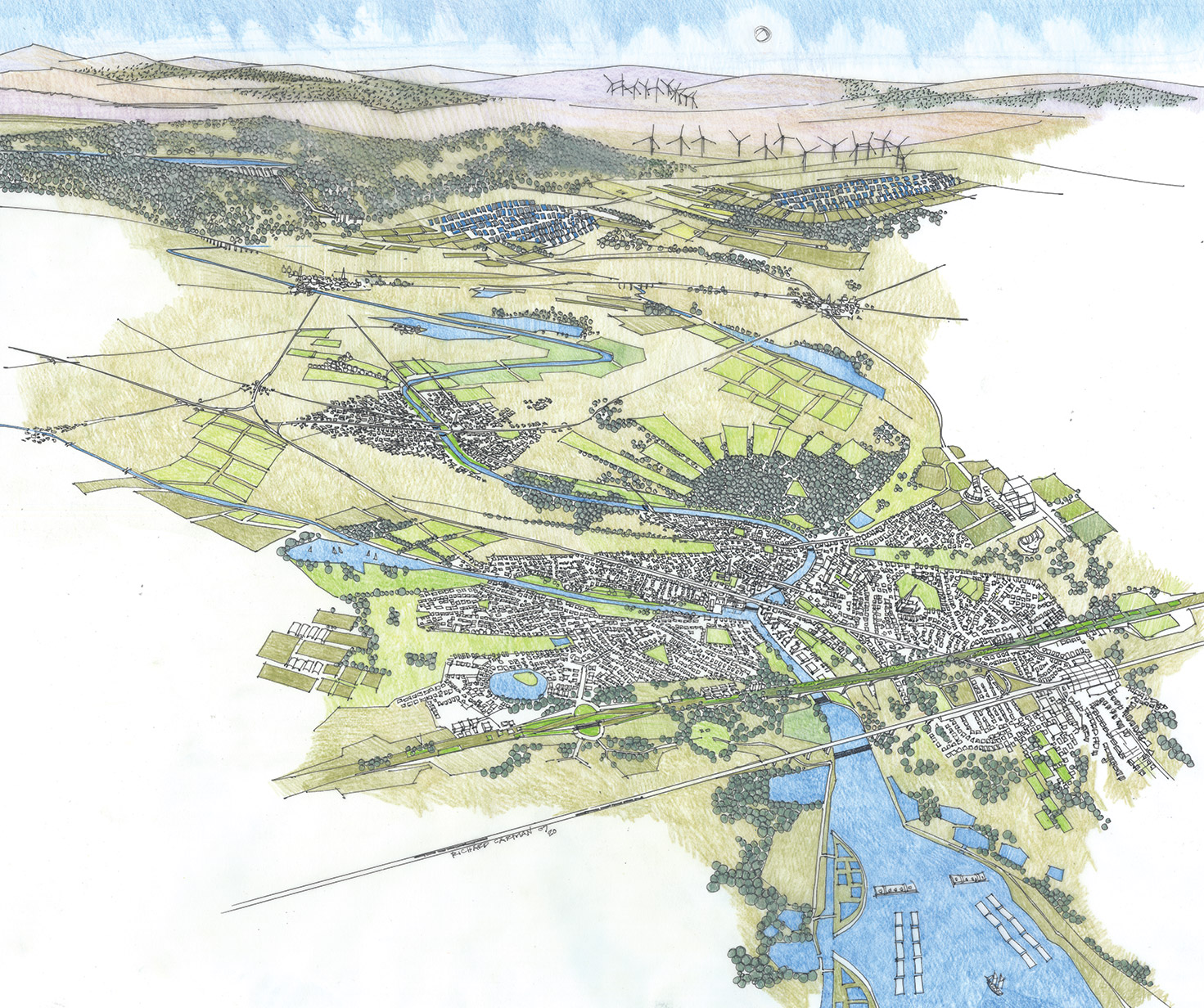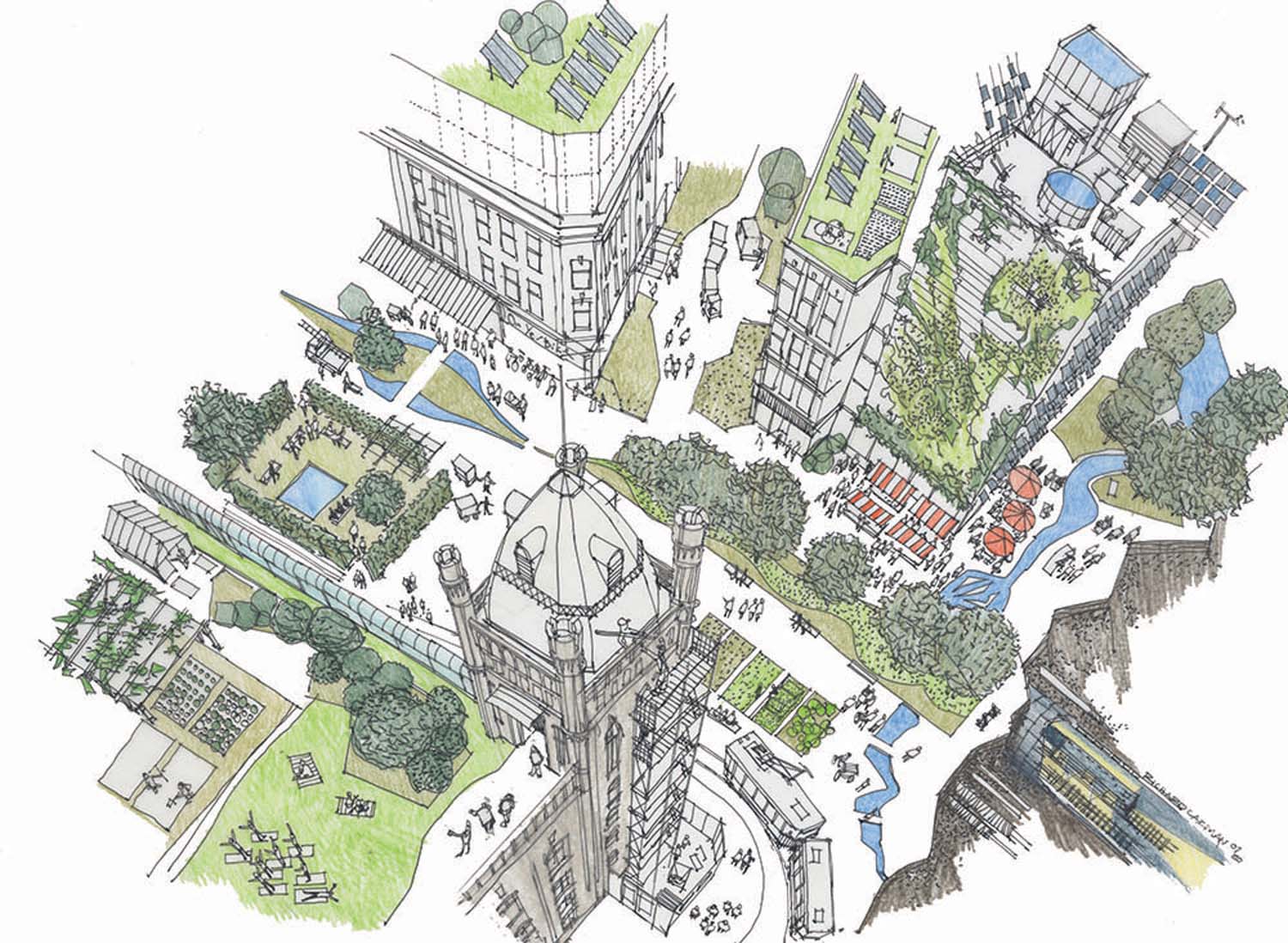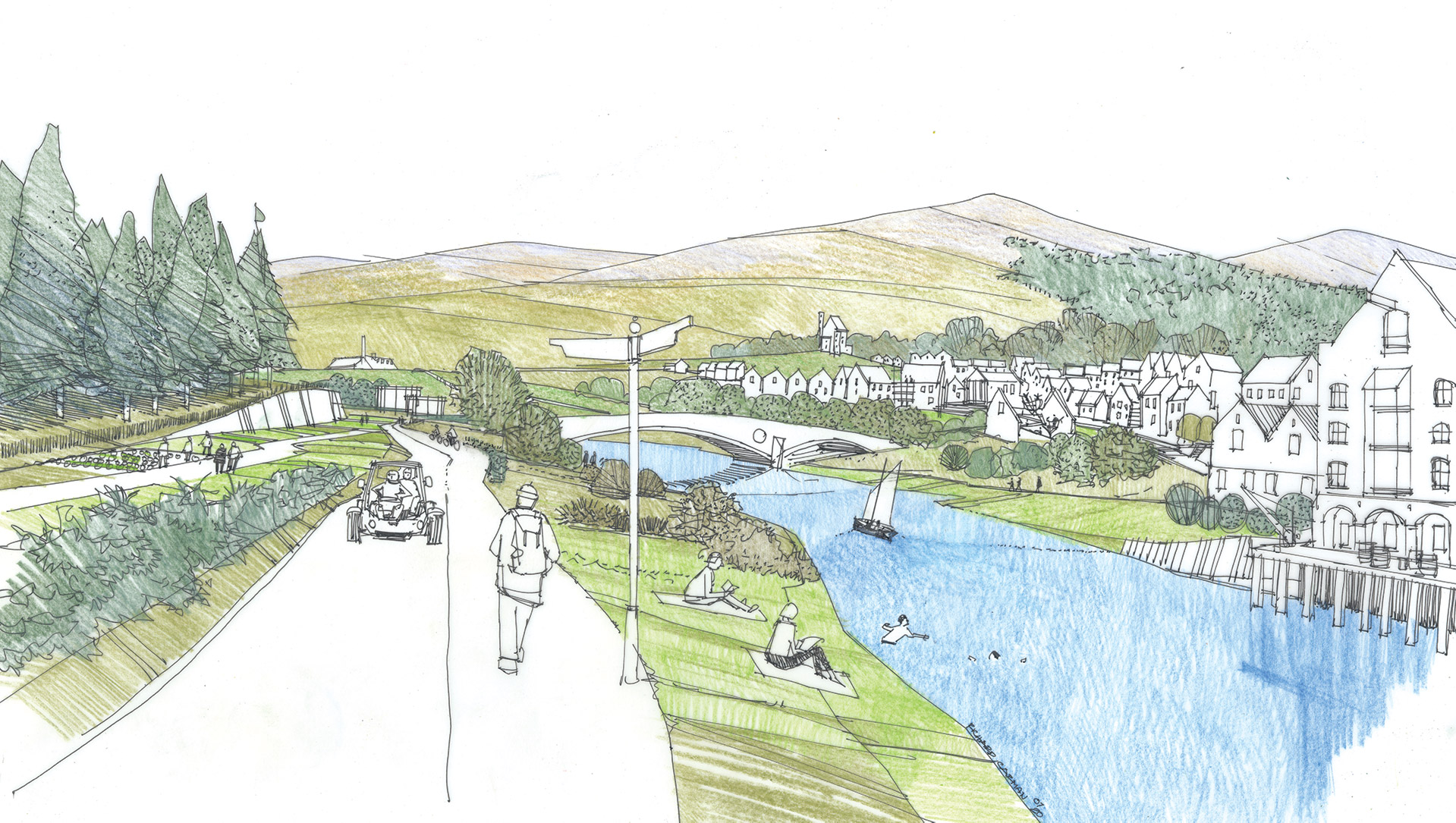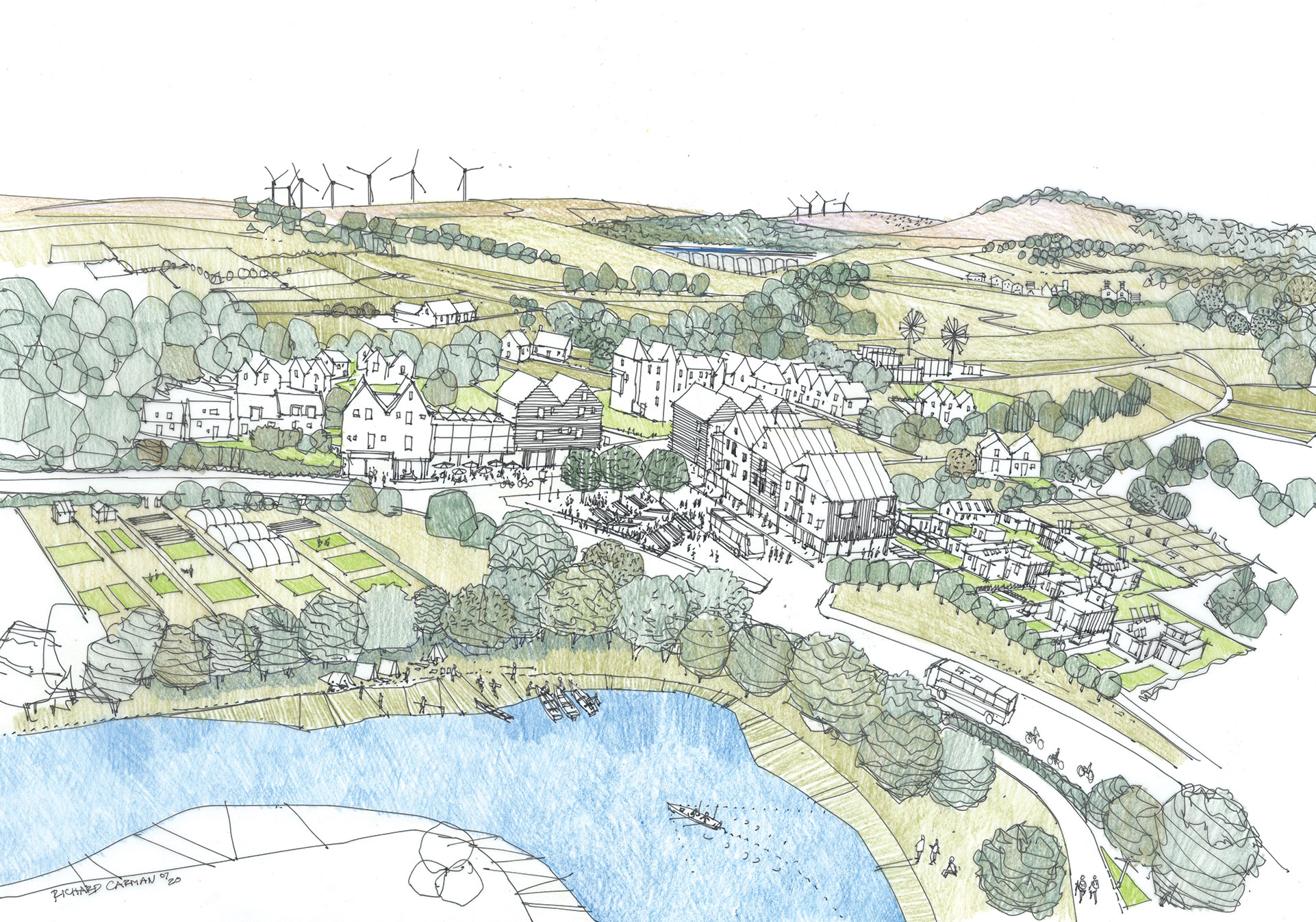The eight principles of a carbon conscious place
The eight principles of a carbon conscious place support a holistic approach to designing and adapting places to reduce, repurpose and absorb carbon.

To protect Scotland from the impacts of climate change, we all need to work together to adapt the ways we live, work, play and move in our cities, towns and villages.
To help realise these ambitions, we are working with communities across the country who are designing carbon conscious places.
The eight principles of a carbon conscious place are the backbone of this work. They support a holistic approach to designing and adapting places to reduce, repurpose and absorb carbon.
The eight principles of a carbon conscious place
The eight principles are interconnected. They are not intended to be used as a definitive list or set of solutions. Instead, they outline important concepts to consider when planning and developing places.
The principles came out of a year of learning in 2019 where we applied our whole place collaborative approach to the net zero challenge.
Read on for an explanation of each principle and examples of each in action.
Understanding, appreciating and working with existing assets, the surrounding landscape and the place identity. Using the right type of intervention, at the right stage, scale and location.
Achieved by:
- gathering and mapping baseline information
- involving the community, local authority, developers, agencies, relevant local businesses and service providers
- ensuring place quality is prioritised in all decisions and investments
The principle in action
The Place Standard provides a simple framework to structure conversations about place.
It allows you to think about a place's:
- physical elements (for example its buildings, spaces, and transport links)
- social elements (for example whether people feel they have a say in decision making)
The Place Standard provides prompts for discussions, which allows for all elements to be considered in a methodical way. This helps to identify the assets and areas where a place could improve.
Creating complete and self-sufficient neighbourhoods with everyday and night services and facilities within a short walking or cycling distance (for example a ‘20-minute neighbourhood’ concept).
Achieved by:
- locating services within local town centres
- co-locating services together in town centres
- improving the connectivity and quality of active travel infrastructure
- enhancing digital connectivity
- improving accessibility to services and public space
- supporting densification and mixed-use developments
The principle in action
The mayor of Paris Anne Hidalgo has followed up her work to create a post-car city with a ‘15-minute city’. Here residents can find everything they need within a 15-minute walk or cycle from home.
The concept helps to create socially and economically mixed districts to improve overall quality of life for residents and visitors.
Mayor Hidalgo's project is inspired by the work of Jane Jacobs, Melbourne’s 20-minute neighbourhoods, and ‘hyper proximity’ in Copenhagen and Utrecht.
Connecting complete neighbourhoods to provide a network of places that support greater self-sufficiency and low carbon living. Enabling people to live, work and play without generating unnecessary carbon emissions.
Achieved by:
- prioritising investment in sustainable public transport networks
- taking an active and landscape infrastructure-first approach
- using mapping to analyse the quality, quantity and accessibility of connections between places
The principle in action
The Borders Railway is the longest new domestic railway to be built in the UK for more than 100 years.
The railway connects and provides a fast and efficient rail link to communities in Edinburgh, Midlothian and the Scottish Borders. It was completed in 2015.
The re-opening of the route has created a significant modal shift from the car to public transport. More than 60% of users state they previously made their journey by another mode. This has saved about 35,800 single car trips. (Transport Scotland, Borders Railway Year 2 Evaluation, 2018)
Placing people’s needs at the centre of decision-making, service provision and investment in our places. Ensuring they are actively involved in important stages of the design process.
Achieved by:
- championing people-centred designed
- using co-design and collaborative engagement tools to involve local people and stakeholders from the beginning and throughout the project
The principle in action
Deveron Projects is based in the rural market town of Huntly in north east Scotland.
Inspired by the work of Sir Patrick Geddes, Deveron Projects connect artists, communities and places through creative research and engagement.
'The town is the venue' describes the framework in which Deveron Projects works to inhabit, explore, map and activate its place through artist-driven projects. This contributes to the social wellbeing of their town.
Retrofitting existing structures and brownfield sites first, giving consideration to embodied carbon in place.
Adding plants to existing hard infrastructure to support climate adaptation and carbon absorption.
Treating structures as ‘material banks’ with demountable, rebuildable, reusable and re-saleable components.
Considering the cost of the entire lifecycle of a structure rather than only its initial capital costs.
Achieved by undertaking an audit of existing land, structures and material to identify which can be used.
The principle in action
Collective Architecture developed proposals for the refurbishment of three blocks of flats located in Woodside, Glasgow.
The refurbishment challenges the current practice of demolishing high-rise residential buildings.
By aiming to achieve the Passivhaus EnerPHit standard for retrofit, the works are a significant improvement on current building regulations. They work towards the mitigation of fuel poverty for the 314 homes.
The works were carried out on behalf of Queens Cross Housing Association.
Joining up the different systems that support a healthy, carbon conscious place: local food, heat, energy, water, green, habitat, transport, waste, housing and social systems.
Enhancing, repairing and joining up the different systems that support a healthy, carbon conscious place. This includes local food, heat, energy, water, habitat, transport, waste, housing and social systems.
Using the landscape as a productive resource. Ensuring the place planning and delivery process understands and supports a whole and circular systems approach.
Achieved by:
- mapping systems to identify deficiencies
- applying a co-ordinated approach that creates co-benefits, multiple outcomes and added value to address those deficiencies
The principle in action
Sheffield’s Grey to Green scheme is the UK’s largest retrofit sustainable urban drainage project. It is also the longest inner city ‘green street’ at 1.6km.
One of the scheme's main functions is to reduce and slow down surface-water runoff. The route runs alongside the River Don and is in an area prone to flooding.
The intended co-benefits include:
- more urban biodiversity
- protection of pedestrians from air pollution with multi-layered planting
- urban cooling
- treatment of contaminated water
- the promotion of health and wellbeing
Supporting the sharing of assets and services in places to enable lower carbon living and connect people to their neighbourhoods.
From the micro to the macro, this can include sharing tools, bikes and electric vehicles to accommodation and education facilities.
Achieved by:
- involving the community, local authority, developers, agencies, relevant local businesses and service providers to find opportunities for a sharing economy
The principle in action
The Edinburgh Tool Library’s goal is to be at the forefront of the sharing revolution by becoming a cornerstone of society.
It plans to extend the influence and reach of its community sites to include the whole of Edinburgh.
It also aims to use its knowledge and experience to establish tool-sharing libraries across the UK with other groups.
It intends to make its vision a reality and impart the values of its work to as many people as possible. It looks to do this by championing reuse, recycling and repurposing as the norm.
Ensuring the place planning and delivery process considers the dimension of time. This includes creating long-term visions as well as using short-term approaches to test interventions.
Achieved by:
- considering the timeline of a place and future evolution
- creating a long-term vision
- building in review periods throughout the delivery to allow the plan to respond to and adapt to wider changes
- establishing long-term place partnerships
- considering the phasing of delivery
- developing meanwhile strategies to support both quick and long-term actions
The principle in action
Glasgow’s Canal Regeneration Partnership has been operating for more than a decade. The partners include Scottish Canals, Glasgow City Council, BIGG Regeneration and two housing associations.
The partnership supports locally driven activities through seedling funding and resources and by helping secure leases.
A cooperative was set up between 20 local organisations to connect community and strategic activities.
Scotland in 2050
What would Scotland look like in 2050 if we took a whole-place approach to designing for a changing climate?
We explore this question through four types of places, considering the eight principles of a carbon conscious place in each: an urban neighbourhood, city centre, town, and rural community.
Each of the example places shows a combination of measures to reduce, repurpose and absorb carbon and adapt to the impacts of climate change.
The mix of measures in each place differs depending on the local opportunities and assets. But as a region, they work together to balance the carbon emitted and absorbed.
This has helped achieve a net zero carbon society and generated co-benefits. These include cleaner air, more resilient neighbourhoods, strong local economies and healthier environments for people and nature.

A Scottish urban neighbourhood in 2050
Walking, cycling, and wheeling have become the common means of travel. Health and education facilities and local shops are close by, following the ‘20-minute neighbourhood’ concept that grew out of the Covid-19 pandemic in 2020.
Street trees enhance the streetscape, providing shade, shelter, a home for nature and carbon absorption.
Sustainably renovated homes provide energy-efficient living and healthy indoor environments. Repurposed garage lockups provide workshops for residents and creative enterprises.

A Scottish city centre in 2050
The idea of hedonistic urbanism, making places fun, together with a zero-emission zone, has helped significantly reduce the number of vehicles in all city centres.
It has left more space for a quality public realm, which has been planted with street trees and rain gardens to protect people from increased rainfall and heatwaves.
Buildings have been retrofitted with green walls and green roofs to cool the urban environment on hot days and slowdown water on rainy ones.
With more people living in the city centre due to the quality of environment, the city centre is a thriving, greener place to be.

A Scottish town in 2050
A ‘Friends of the River’ group played an active role in the transformation of the river into a key asset for the town.
The group worked with the local authority and key agencies to attract investment for a natural flood defence scheme upstream.
This has turned the riverside into a much-loved open space in the town with people exercising, relaxing, or having meetings there.
It is now also used to transport locally-produced goods between communities by sailboat – an unintended positive co-benefit.
With fewer people using private cars, the declassified road has been turned into a national active travel superhighway.

A Scottish rural community in 2050
Rural communities have become known as the ‘green lungs of Scotland,’ helping balance Scotland’s overall carbon emissions with their peatland and woodland restoration.
Through meaningful community involvement, new eco-friendly housing has been constructed using local timber and low-impact renewable materials to absorb carbon.
High quality, regular and reliable public transport and good active travel links connect the area to surrounding towns and villages. Community-owned wind turbines provide electricity to the settlement through a local energy grid.
Find out more
Our Designing for a Changing Climate: Carbon Conscious Places report explores the eight principles in more detail, including how they came about, and the visions of Scotland in 2050 in full. Watch the report launch here.
Image credits: Richard Carman
Share your place-based climate action
We would like to hear from communities and local authorities who are creating carbon conscious places. If you are designing and adapting a place to reduce, repurpose and absorb carbon, please share examples of your work with us.
